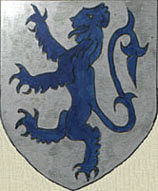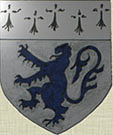CORPORAL HARRY LEEKS OF
NORTH SKELTON.
 |
 |
Harry Leeks lost his life in the First World War on the
11th January 1917, while
serving with the local, 4th Battalion of the Yorkshire Regiment.
He was just 21 years of age.
Andrew Berwick is the grandson of Harry's younger
sister, Alice, and he has kindly sent these
photographs;
as well as family details and an extract from the 4th Battalion Diary
of the time.
Click
here to see them.
|
TROUTHALL FARM. 1850 TO
1881.

Trouthall Farm 2006.
|
The following emails were received from Alison Preston and Hamish Brown
of Auckland, New Zealand.
I have just come across your most fascinating and detailed website on
Skelton.
Many congratulations on such a fine work!
My particular interest is with the Wood family who lived at Trout Hall
farm from before 1861 to about 1883.
William Wood was my Great Great Grandfather.
I am particularly interested in how William came to be the farmer at
Trout Hall and who owned the land at that time.
William was born in Berwick-Upon-Tweed, as the son of a butcher and
small-time landowner.
His brothers and sisters all seem to have stayed around Berwick but I
have been unable to trace how William came
to move to Skelton and be, apparently, relatively successful.
In 1870, William, then aged 42, married 27 year old Sarah Jane
Richardson, the youngest daughter of prominent local Quaker John
Richardson of Langbaraugh Hall, Great Ayton.
|
The marriage took place at an independent chapel (probably
Friends Meeting Room ) in Great Ayton.
John Richardson does not appear to have been impressed by this
marriage, as he changed his will to ensure that Sarah Jane's portion of
his estate was held in trust for her by her brothers.
This was at a time when she had already produced several children.
He eventually changed the will again to give Sarah Jane her own share.
He died in 1881 shortly after the census, and it is probably not a
coincidence that Sarah Jane and William moved to the Berwick area
within 2 years
They almost certainly used Sarah Jane's share of his estate to build
themselves a house in Duddo, Northumberland.
Their Skelton-born sons John and William were pupils at Barnard Castle
School in 1891.
I am not sure whether this was a Quaker School, or whether the family
had lapsed by that time.
I would be very interested to find out the following:
Who owned Trout Hall farm while William Wood was in residence between
1861 and 1881 ?
[The Middlesbrough Estate seems to come up on a few archive searches,
with members of the Pease family mentioned.
They were relatives of the Richardsons.
When did William Wood take over Trout Hall farm, and from whom ?
I have not been able to trace him or Trout Hall Farm in 1851 census.
Are there any lists of Quakers in Skelton, and if so was William Wood a
Quaker ?
I suspect this may well be the reason that his father in law did not
approve of him, apart from age and class differences
I would be most interested if you have come across any of this
information in your research.
Thank you so much for the photos.
They give a wonderful idea of what the house must have looked like 150
years ago.
I'd be very interested if anyone ever has any more information, or if
another descendant ever contacts you.
It seems like the Stevensons [the present occupants of Trouthall
Farm] were there from at least 1885.
They were living there at the time of the 1891 census, and daughter
Elizabeth was born in Skelton in about 1885.
It would be interesting indeed to find out who the owner of the farm
was at that time.
I'm not quite sure how far it is to Great Ayton, but it's not
impossible that the land owner was John Richardson,
as he certainly seems to have owned various farms.
I've been piecing together family history for a couple of years, and am
lucky enough to have my great grandmother Jemima Wood's (born at Trout
Hall in 1871) copy of The Richardsons of Cleveland.
Records of a Quaker Family by Anne Ogden Boyce, published in 1889.
The best thing about this is detailed family trees for all the various
branches of the Richardsons,
who originated in Whitby.
The North East Quaker families all intermarried on many occasions, so
the Richardsons are linked in with
the Peases (of Barclays bank fame), the Rowntrees, the Carrs (biscuits)
and many other such families.
The best known Richardson was Thomas, a very wealthy banker, who died
in about 1850, and who was the major benefactor of Great Ayton school.
In partnership with his brother in law he funded much of the early
railway development in the area.
I'll try to have a look through the book to see if there is any
reference to Skelton.
There's a lot about Great Ayton, and even a description of Langbarough
House, which is great.
I have also been lucky enough to obtain a copy of John Richardson's
will, and have birth/marriage/death certificates for my own relatives,
so have pieced together much information together with censuses and
trade directories.
I'm now trying to take it all a stage further, and have found out from
on-line searches in Teesside Archives that there are quite a few
records relating to Middlesbrough Estate for the area, which indicates
that there was quite a bit of property in the area owned by a
consortium of the Quaker families.
If I find out more, I'll let you know.
|
|



